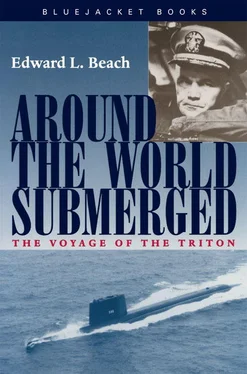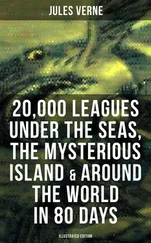As Diving Officer, Tom’s job was to work out the compensation under the load condition that existed at any given time, and to calculate exactly how much water was required in each variable tank to insure that when Triton ’s main ballast tanks were flooded, the ship would be both in neutral buoyancy and balanced fore and aft. When the right amounts of water are thus in her variable tanks, the ship, in submarine parlance, is in “diving trim” or “compensated.”
“The ship is rigged for dive and compensated, Captain,” Tom reported.
A submarine cannot submerge until it is “rigged for dive,” by which is meant that all the proper equipment for diving is in correct position, either open or shut, in power or set for hand operation as designated, and that every compartment has been inspected, both by the crew members responsible for rigging it and by an officer detailed to check it. There have been cases when a submarine was lost, seriously damaged, or suffered loss of life because of an improper rig somewhere.
“How is your trim?” I asked.
“I’ve pumped it all in,” Thamm said. He added, “I guess we’ll find out how good the trim is as soon as we pull the plug.”
The indicator lights on the Ballast Control Panel showed that we were ready to dive, except that our main air inlet pipe and the bridge hatch were still open.
“Shut the induction, Tom,” I said.
At Thamm’s signaled order, Fitzjarrald, hovering over the Ballast Control Panel, moved the control toggle switch to the shut position.
I picked up the microphone controlling the speaker on the bridge, told Brodie to reduce speed and shift his watch to the conning tower. There was a “clink” of annunciators, a clatter of feet on ladder rungs, a thump as the bridge hatch slammed shut. The Ballast Control Panel indicated that the last important hull opening was now closed.
“All clear topside!” Brodie’s voice came from the conning tower, where, according to plan, he would be manning the periscope.
“Bleed air, Tom,” I said.
Thamm picked up a microphone in his turn. “Engine room, this is control. Bleed high-pressure air into the ship!”
For our first dive, we were using the so-called “safe-diving procedure.” For the moment, we were driving along on the surface, entirely sealed, with no one topside. In the meantime, high-pressure air was being released from a connection in the engine room to increase the air pressure slightly within Triton ’s hull. If air could not leak out of the ship, then presumably water could not leak in. At the Diving Control Panel was a barometer which would indicate the pressure inside the ship. If this pressure rose and did not drop back after the air valve was shut, the ship had to be airtight.
Thamm, Fitzjarrald, and I inspected the barometer closely. The needle rose a short distance, then stopped rising and remained rock steady.
Tom took a long minute to watch it carefully. Finally satisfied, he nodded to me. “The ship is tight, sir.”
An interested group of observers had silently gathered in the control room. All experienced submariners, some of them tops in the field of submarine construction and design, every visitor aboard had a keen interest in Triton ’s first dive. I gave Brodie the order to sound the diving alarm, and a raucous, automobilelike horn reverberated through the ship. Fitzjarrald, his hands on two of the control buttons on the Ballast Control Panel, was watching Thamm.
“Open the vents,” Tom ordered.
Swiftly, the Chief ran his fingers down the panel of switches opening Triton ’s main vents to the sea. The rush of water into the tanks could be heard through the thick steel plating of the ship’s hull.
Thamm waited several seconds, then ordered, “Shut the vents.”
This also was by prearrangement. Our purpose on this first dive was to ease Triton down into the depths easily and gently. Should something be radically wrong with the compensation, or should the controls somehow fail to function properly, we wanted to be able to regulate things immediately. Eight thousand tons of insensate steel running out of control could be a frightening, possibly disastrous experience.
Another long moment went by while Thamm checked all his instruments. Though lower in the water by several feet, Triton was not yet submerged. Again Tom ordered the vents reopened, and again he shut them. The third time he opened them still longer, and as we felt Triton angling down at the bow, he opened them all. It had taken us several minutes to dive, but we were all well satisfied; our ship had performed exactly as we had predicted. Later, of course, we would strive for a faster diving time.
The submerged trials started out simply, but rapidly increased in severity. Soon we were running the entire gamut of submerged operations, and our feeling of pride and confidence in our ship grew steadily. Triton behaved beautifully, like the queen she was designed to be. Despite her huge bulk, she could turn around so fast that her gyrocompass indicator would spin like a top in front of the helmsmen. When up or down plane angles were used, she responded immediately—and the smallest angle on the planes was sufficient to bend her to our wishes. When “flank speed” was ordered, we were surprised and delighted; surfaced she was by design faster than any submarine, faster than most surface ships, in fact. Speed under water had been a secondary consideration; yet, submerged, only her immediate predecessor, the football-shaped Skipjack, could equal her. There was absolutely no sensation of passage through the water, nor any water noise. Much of the noise created by a speeding ship is a result of the mixture of air and water at the surface. Thus the water noise is largely a boundary effect. But when the ship is deeply submerged, there is no such boundary, no opportunity for air to mix with water. Our superstructure and hull were firm and solid; there was no rattling or vibration here either; no noise of any kind except for Triton ’s propellers and internal machinery back aft.
Whenever I could absent myself from the control room, which was not very often on this first day under way, I took a turn through the machinery spaces. There, everyone was smiling. Assistant Engineer Don Fears, part of the time Engineering Officer of the Watch in number two engine room and later occupying himself by a continuous working check of all operating equipment, reflected joy and pride every time I saw him. So did Les Kelly, who, as Triton ’s Chief Engineer, had overall responsibility for the entire plant. Pat McDonald, our Reactor Control Officer, responsible for theory and practice insofar as the reactors were concerned, was positively ebullient.
“How’s it going, Pat?” I asked him, cornering him in the reactor monitoring area which someone—Pat himself, I had always suspected—had nicknamed “Idiot’s Alley.”
“Just fine, Captain, just fine!” answered Pat. “She’s humming away like a big watch. I wouldn’t be afraid to take her clean across the Atlantic this very minute—just look at this!”
Pat pointed with his slide rule to one of the hundred or so “read-out” indicator dials which lined both sides of “Idiot’s Alley.” I looked. The Power Output dial was approaching the edge of the full power mark.
“We crept up on it slowly,” said Pat, “but we’ve been running just below full power now for the past hour and a half. The Admiral sure believes in working out the machinery!”
“You can say that again,” I told him. “When the Nautilus prototype out in Idaho was first fired up, he made them take it on a simulated voyage at full power all the way to Europe. Regular watches, course charted, daily positions, and all that. There weren’t many who said it wouldn’t work after that.”
Читать дальше












